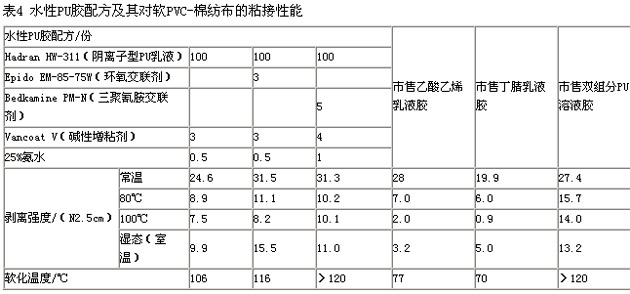(2) Fabrics and flocking Waterborne polyurethanes are used as fabric adhesives, which have excellent adhesive properties and flexibility. They can be used to make high-quality composite fabrics, non-woven fabrics, and carpets.
For example, BPl42910 uses PPG, TDI, DMPA, a small amount of TMP, 20% plasticized poly and a small amount of other additives made of PU emulsion, after thickening to get a solid content of 40% of the adhesive, with a doctor blade to apply it on the twill, With flocking of short rayon and drying at 150°C for 5 minutes, the performance of the flocked fabric was tested to Grade A. In addition, PU emulsions can also be used for electrostatic flocking on substrates such as PVC.
(3) Bonding processing of various substrates Water-based PU can be used for plastic sheets or films such as PVC, PET, PP, ABS, PE, fabrics (cotton or chemical fiber), non-woven fabrics, paper, glass, etc. Adhesives are bonded or laminated.
For example, aluminum-kraft paper is widely used as a building construction component in foreign countries. In the past, it was produced using an ethylene-acrylic acid copolymer emulsion adhesive. After changing to a water-based PU emulsion with a solid content of 35% to 40%, the peel strength was doubled. The laminates (such as polyethylene-polyester, etc.) used in certain foreign instruments, automotive decorative materials, etc., also have higher peeling strength when using aqueous PU than solvent-based PU.
The use of PVC sheet or film as a substrate for lamination can be used in many ways, such as the decoration of interior materials, not only requiring strength at room temperature, but also requiring resistance to hydrolysis, heat and durability under harsh conditions, water-based PU The glue has excellent adhesion to PVC (see Table 4).

(4) Pressure-sensitive Adhesives In view of aging resistance, adhesive strength, transparency, and non-toxicity, acrylic emulsion adhesives are currently used for emulsion pressure-sensitive adhesives. The PU has a high bonding strength, heat resistance, cold resistance and other properties, is a new and excellent variety of emulsion pressure-sensitive adhesive, the substrate is mainly paper, fabric and plastic film. PU emulsions for pressure-sensitive adhesives generally have a lower molecular weight than general adhesive emulsions.
Japanese Patent Laid-Open No. Sho 62-297375 reports an anionic PU emulsion developed by Kao Corporation of Japan, which is cross-linked with epoxy, and the properties of the pressure-sensitive adhesive obtained are shown in Table 5.

(5) Other products developed by HB Fuller and others include WD-4003, WD-4006, and WD-4907. After they have been adhesively cross-linked for various types of materials, their adhesive strength is very high. Zeneca Resins products are NeoRez R-563 (for PVC film lamination), Ne-oRez R-550 (for footwear and cold contact adhesives), NeoRez R-987 and Neo-Rez R-551.
The cost of polyurethane is higher. The polyurethane content of the different polyurethane dispersion products is different. In the automotive industry, the polyurethane content is 25% to 30%, while the polyurethane content in the footwear industry is as high as 60%. Adding low-cost resin to the formulation can increase certain special applications. Adding EVA or rosin to increase tackiness of the product, and adding modified terpene phenolic resin can improve creep resistance.
According to estimates by Zeneca Resins, the European market needs more than 6,000 tons of polyurethane annually, and the automotive industry is the largest market, mainly used for bonding plastic parts. Germany is the largest consumer of polyurethane dispersions and it is expected that in the future it will maintain a rapid growth rate of 8% to 10% per year. This is not only an environmental protection requirement, but also the performance of polyurethane dispersions is quite similar to that of traditional solvent-based systems. Is a major reason.
Source "Polyurethane Resin and Its Application", Li Shaoxiong Liu Yijun







